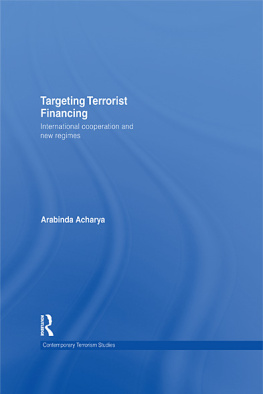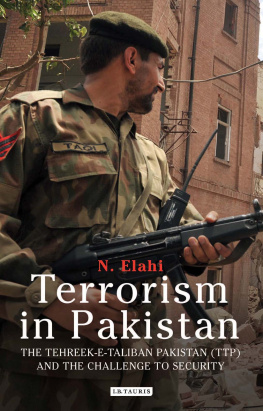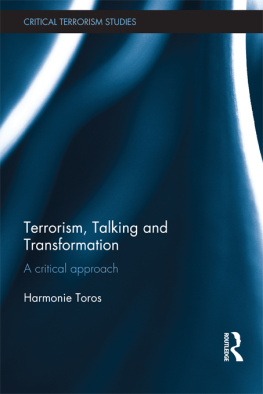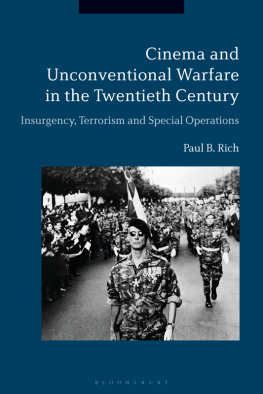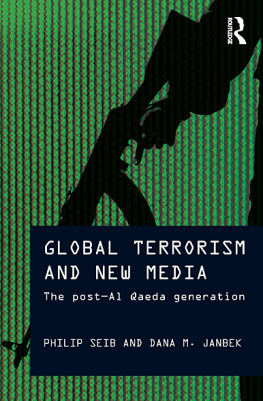Terrorism, Inc.
The Financing of Terrorism, Insurgency,
and Irregular Warfare
COLIN P. CLARKE
Praeger Security International

Copyright 2015 by Colin P. Clarke
All rights reserved. No part of this publication may be reproduced, stored in a retrieval system, or transmitted, in any form or by any means, electronic, mechanical, photocopying, recording, or otherwise, except for the inclusion of brief quotations in a review, without prior permission in writing from the publisher.
Library of Congress Cataloging-in-Publication Data
Clarke, Colin P.
Terrorism, inc. : the financing of terrorism, insurgency, and irregular warfare / Colin P. Clarke.
pages cm. (Praeger security international)
Includes bibliographical references and index.
ISBN 9781440831034 (hard copy : alk. paper) ISBN 9781440831041 (ebook) 1. TerrorismFinance. 2. InsurgencyFinance. 3. Irregular warfare. I. Title.
HV6431.C522015
363.325dc232015004931
ISBN: 9781440831034
EISBN: 9781440831041
19 18 17 16 151 2 3 4 5
This book is also available on the World Wide Web as an eBook.
Visit www.abc-clio.com for details.
Praeger
An Imprint of ABC-CLIO, LLC
ABC-CLIO, LLC
130 Cremona Drive, P.O. Box 1911
Santa Barbara, California 93116-1911
This book is printed on acid-free paper 
Manufactured in the United States of America
Contents
Preface
Terrorism, insurgency, and irregular warfare (IW) are defining features of conflict in the twenty-first century. These types of conflict are indicative of the harsh reality of both the current and future operating environments. As globalization accelerates unimpeded, a host of continuing trends reinforce the threats posed by violent non-state actors operating in a milieu that can be most aptly described as complex and unpredictable.
Although the United States eschewed more direct involvement in Syria (at least as of early 2015), her status as the worlds preeminent global power will no doubt necessitate future involvement in various failed states, alternatively governed spaces and other zones of instability. Whether fighting against ethnically-based militias, warlord-led criminal gangs, or transnational terrorist and insurgent groups, combating how these entities are funded and financed will remain a critical challenge. This challenge is compounded by the globalization of banking and finance and the ubiquity of communications and information technology that facilitates the virtual movement of money.
In 2015, the international security landscape is as pernicious as ever. Despite a massive commitment of resources, the United States was never able to completely stabilize Iraq or Afghanistan, which still continue to battle overlapping insurgent groups and terrorist organizations. Iran continues to support myriad terrorist organizations throughout the Middle East, and Al-Qaida has evolved from an organization based in South Asia to a networked model of regional affiliates stretching from the Sahel to the Arabian Peninsula to the Horn of Africa. The threat from one of Al-Qaidas spawn, the Islamic State of Iraq and Syria (ISIS) is as tangible as it is enduring.
This book will analyze seven terrorist and insurgent groups to determine how these groups fund their organizations, the various ways in which funding supports their operational and organizational capabilities, and how this funding could be disrupted. The groups covered are geographically diverse, rely on a wide range of tactics and sources of financing, and face a multitude of states and organizations seeking to disrupt and dismantle their activities and infrastructure. Historical lessons learned will inform policy recommendations for the cases still ongoing. This research should be interesting to a range of individuals and organizations, including academics and scholars, military leaders, policymakers and government officials, as well as banks, financial institutions and other multinational corporations concerned with the growing challenge of analyzing threat finance.
This book will proceed as follows:
CHAPTER 1. INTRODUCTION
Chapter one lays out the motivation for this book, introducing the analytic framework of the gray and dark economies. Next, chapter one reviews the various operational and organizational capabilities of terrorist and insurgent groups. Finally, the chapter provides a synopsis of the various means of combating the financing of terrorism, including both kinetic and non-kinetic efforts pursued by states and governments, as well as a brief history of the evolution of the effort to combat the financing of terrorism.
CHAPTER 2. THE PROVISIONAL IRISH REPUBLICAN ARMY (PIRA): THE TROUBLES IN NORTHERN IRELAND
details how the PIRA relied on a range of activities to finance the insurgency in Northern Ireland over the course of 30 years, including diaspora donations from abroad (especially the United States), armed robbery, extortion, and coercing shopkeepers and business owners into paying protection money. Less lucrative but still valuable activities included income tax fraud, livestock smuggling (pigs, cattle, and bovine antibiotics), film piracy (including pornography), and automobile theft. The group also relied on legitimately owned businesses and has counted pubs, private security firms, taxi cab services, construction firms, and restaurants among its licit activities through which to both earn and launder money. These funds were used to purchase sophisticated weaponry, sustain its members, provide for the families of those members in prison, and develop a mature propaganda campaign. In time, the PIRAs funding stream afforded the group with the ability to transition to politics, embodied in its political wing, Sinn Fein. The British government relied on an extensive counterintelligence network to disrupt PIRA finances, while also targeting the groups leadership for kill, capture, arrest, prosecution, and imprisonment.
CHAPTER 3. THE LIBERATION TIGERS OF TAMIL EELAM (LTTE): A DIVERSIFIED FUNDING PORTFOLIO
traces the rise and fall of the Tamil Tigers. Between its inception as an insurgent group in the mid-1970s and its demise in late 2009, the LTTE developed perhaps the most comprehensive array of military capabilities ever demonstrated by a terrorist group. Driving these capabilities was a diversified network of fundraising activities, ranging from extortion to human smuggling to armed robbery. The Tamil Tigers posed a truly asymmetric threat to the government of Sri Lanka and with the aid of its funding, boasted a navy, an air force, and an elite suicide commando unit used to assassinate heads of state and COIN force commanders. A transnational diaspora network provided propaganda, funding and weaponry to sustain the Tigers for most of the groups existence. The Sri Lankan government and its armed forces never effectively disrupted the LTTEs financing and only defeated the group through a scorched earth campaign that included mass atrocities against civilians.
CHAPTER 4. HEZBOLLAH: FINANCING THE PARTY OF GOD
assesses Lebanese Hezbollah, a group that relies on support from Iran, a worldwide diaspora, and an extensive criminal portfolio to sustain its military capabilities and robust network of social services. Some of the larger services include Jihad al-Binaa (JAB), or Construction Jihad, the Islamic Health Committee (IHC), and the Relief Committee of Imam Khomenei (RCIK). The groups funding allows Hezbollah to maintain a vast arsenal of weaponry to expand its attack capability, sustain its operations over the long-term, inflict psychological damage on its adversaries, and diversify its methods and tactics. Multiple entities have attempted to combat Hezbollah, including the Lebanese government, the state of Israel, and the United States, although counter-threat finance efforts by each of the aforementioned have been met with mixed success. In turn, Hezbollah remains anchored in Beirut and its surrounding environs as perhaps the worlds most capable hybrid actorpart terrorist group (with some conventional capabilities), part socio-political organization. The result has been a muddled response from those unsure of how to deal with this type of IW threat.
Next page

